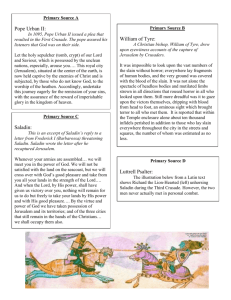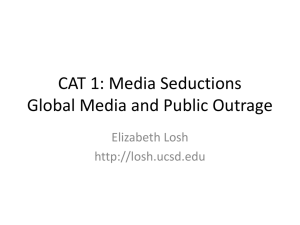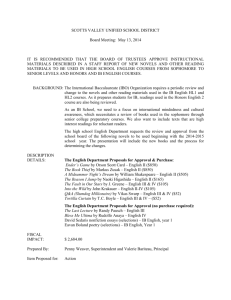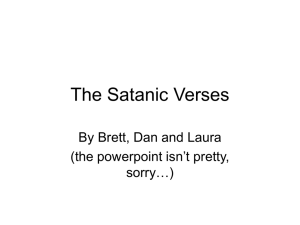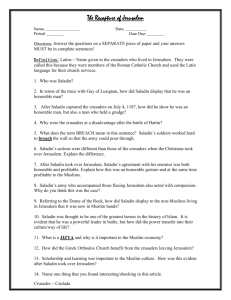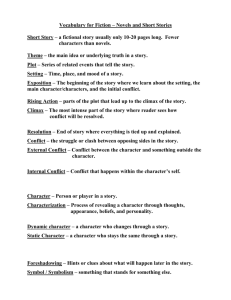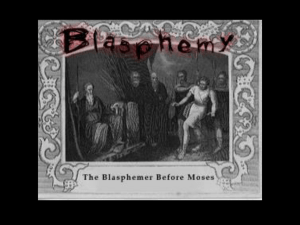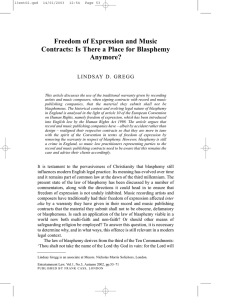Slides - Elizabeth Losh
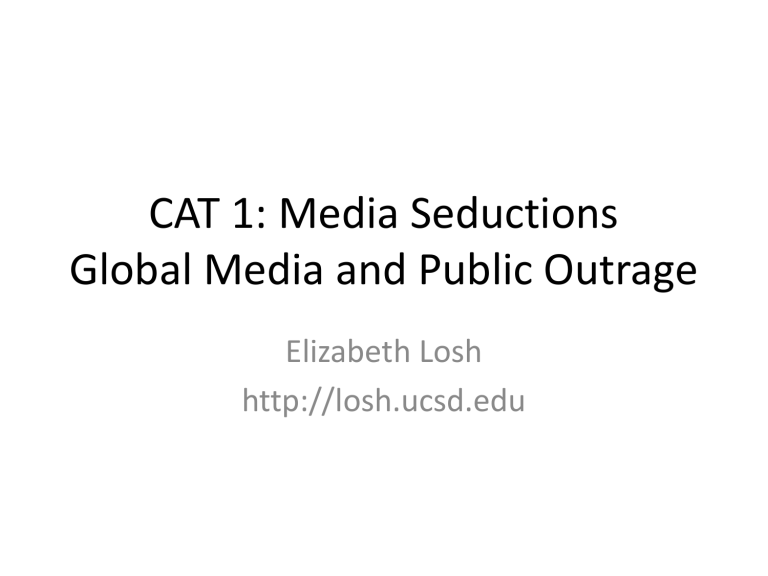
CAT 1: Media Seductions
Global Media and Public Outrage
Elizabeth Losh http://losh.ucsd.edu
Charting Out Works
Synthesizing Information for the Final Exam
• Medium/Media . . . about Medium/Media
• Losh Thesis/Theses
• Level of vividness and interactivity
• Genre(s)
• Historical Context (especially with regard to culture, art, and technology)
• Scholarly disciplines weighing in on media influence
• Moral panics, censorship, or prohibitions on what can be represented
• Physical impact of media on the body or on the senses (how do horror, melodrama, etc. work physiologically)
• What does this work say about questions of audience? Who is vulnerable to a particular kind of media experience?
• Attitudes about nurture vs. nature (including race and gender)
• Narrative Features (captivity, conversion, etc.)
Sample: Northanger Abbey
• Book . . . about Books (with some painting, sculpture, and architecture, but almost no music)
• Books are conventionally thought of as lacking vividness and interactivity, but
Austen highlights the imaginative engagement of readers
• Novel of manners that satirizes gothic novels
• The Age of Sensibility: new book technologies had arrived but reading was still a social practice regulated by cost, female readers and writers were composing works in greater numbers, and Jane Austen introduced free indirect discourse as an artistic technique rather than epistolary or diaristic formats as a way to engage readers.
• Literary theories of Burke (sublime and sensibility) and Johnson (suspension of disbelief)
• Criticism of the educational value of novels in relationship to history and essays; the danger of confusion of novel plots with real life; defense of novels too
• Catherine experiences horror (and some melodrama as she thinks about the dead
Mrs. Tilney), and John experience pornographic fascinations
• Women aren’t always good readers or writers, but not more vulnerable to novels
• Education is important, and the equality of the sexes is assumed
• Our heroine is held captive – but in a less dramatic way than she imagines – and she converts after her humiliation, but not as much as her father-in-law
Sample: Uncle Tom’s Cabin
• A play that was a multimedia spectacular with songs and tableaux vivants and elaborate stagecraft and Jim Crow show elements (some discussion of photography as well)
• Adapted in ways to increase the vividness of the experience in 2-D and 3-D space and appropriated for many purposes (including non-abolitionist ones)
• Melodrama
• The lead up to the Civil War: novels now had to compete with new technologies like sheet music and photography
• Political and theological human rights discourses about the abolition of slavery
• The literacy narrative of Tom in the original novel is deleted.
• “Any mind that is capable of real sorrow is capable of real good.”
• Mocks Northerners and their hypocrisy, even though they are the intended audience.
• Children are depicted as more pure, not corrupted by society. The naturalness of their being divisions between the races is questioned. Women are expected to manage the domestic sphere.
• Very different from autobiographical slave narratives as a captivity narrative in that
Uncle Tom wants to go home not leave the plantation; many different conversion narratives in the story
Why does Uncle Tom’s Cabin keep reappearing in The Satanic Verses?
“Brown Uncle Tom” (276)
“Topsy and Legree” (304)
A Sample Artifact and a Sample Passage
“then it turned out that the previous lover of his beloved
Renata was the exiled boss of the SAVAK torture organization of the Shah of Iran.” (213)
“But the true moral of the fable was the need for vigilance.
London was a city in which the ex-boss of SAVAK had great connections in the telephone company and the Shah’s exchef ran a thriving restaurant in
Houndslow. Such a welcoming city, such a refuge, they take all types.” (214)
Gilles Peress IRAN. Teheran. 1979. Savak agents on trial at Evin Prison. Magnum
Photos.
How do we understand The Satanic Verses as a book about media not just a book about religion?
Why won’t plot summaries help?
The Structure of the Book
Part I: The backstory on Gibreel and Saladin
Part II: Muhammad in Mecca before Medina
Part III: Gibreel and Saladin among strangers in London
Part IV: The backstory on the pilgrimage of Ayesha’s village
Part V: Gibreel and Saladin reconnect with their past in their new identities
Part VI: Muhammad in Mecca after Medina
Part VII: Gibreel and Saladin’s story continues
Part VIII: The disastrous consequences of Ayesha’s pilgrimage
Part IX: The conclusion of Gibreel and Saladin’s story
The Story You Don’t Read
Ayesha: The girl who eats butterflies
What is the Hajj?
The Beginning of Part III: Gibreel’s Story
Rosa Diamond, Argentina, and Magical Realism
Rushdie’s homage to Gabriel García Márquez,
Alejo Carpentier, Jorge Luis Borges, and Laura
Esquivel.
147-161: A story of the Peronist legacy
The Beginning of Part V: Saladin’s Story
A Bangladeshi family running a rooming house
How do the narrative techniques of Hind’s story differ from Catherine Morland’s story
253-259: A story of marital disappointment
Other Diasporas in London
Part III: Why did the authorities think
Chamcha is a “Packy”? (162)
Part V: Why doesn’t Allie know what a
“Packy” is?
‘It’s the last week this week. Twenty-three years I’ve been on this corner and the Pakis have finally driven me out of business.’ She heard the word p-a-c-h-y, and had a bizarre vision of elephants lumbering down the
Moscow Road, flattening Sunday news vendors. ‘What’s a pachy?’ she foolishly asked and the reply was stinging: ‘A brown Jew.’
(310)
How does Chamcha understand his racial and class identity?
My Beautiful Laundrette
(1985) http://www.youtube.com/watch?v=75wusZCurCw&
‘Where else would you go to heal your disfigurements and recover your normal health?
Where else but here, with us, among your own kind?’
(261)
‘I’m not your kind,’ he said distinctly into the night.
‘You’re not my people. I’ve spent half my life trying to get away from you.’ (262)
Chamcha’s Quest to Assimilate
Had he not pursued his own idea of the good, sought to become that which he most admired, dedicated himself with a will bordering on obsession to the conquest of
Englishness? Had he not worked hard, avoided trouble, striven to become new?
Assiduity, fastidiousness, moderation, restraint, self-reliance, probity, family life: what did these add up to if not a moral code?
(265)
Margaret Thatcher (1925-)
Prime Minister 1979-1990
Immigration policies in multicultural London were enforced by the conservative government and sometimes even by street vigilantes.
“Mrs. Torture” (275)
“Maggie the bitch” (278)
“Maggie-maggie-maggie, bays the crowd. Burn-
burn-burn.” (302)
“his beloved Mrs. Torture” (531)
The 1982 Falklands War
(181, 277)
Boney M. Returns (182)
Club Hot Wax
(198, 293, 300-301)
A culture around “daytime discos”
The underground music scene of
“bhangra beat shows” (293)
DJ Ritu
The Popularization of Punjabi Music http://www.youtube.com/watch?v=9Qj7Y0qXJZ4&
Part V: Ch. 1
The Devil as Political Revolutionary
“Satan
Arousing the
Rebel Angels” from William
Blake’s
Paradise Lost
An older kind of “sympathy for the devil”
Blake’s Marriage of Heaven and Hell (315)
The purpose of the Defoe epigraph
Very quickly, because nothing takes a long time any more, the image of the dream-devil started catching on, becoming popular, it should be said, only amongst what Hal
Valance had described as the tinted
persuasion . . . The kids in the street started wearing rubber devil horns on their heads
(295)
The romance of outlaws
Thus, Chamcha realized, people must once have applauded and giggled at the deeds of earlier outlaws, Dick Turpin, Ted Kelly, Phoolan
Devi, and of course that other Billy: William
Bonney, also a Kid. (272)
Chamcha’s voice
“a voice so diabolically ghastly and guttural”
(294)
“roaring out a song at the top of his voice, which sounded so alien and full of static that she couldn’t make out a word” (295)
“singing in a voice so vilely hoarse that it was impossible to understand the words” (300)
Gibreel’s film plans
Is “fiction fiction” and “facts facts”
“The film was to be – what else – a theological, but of a new type. It would be set in an imaginary and fabulous city made of sand, and would recount the story of the encounter between a prophet and an archangel; also the temptation of the prophet, and his choice of the path of purity and not that of base compromise.” (281)
Production begins
Gibreel in Jahilia, Gibreel Meets the Imam,
Gibreel with the Butterfly girl . . .
‘Stostorylines, draft scenarious, cacasting options are already well in haha hand.’ (356)
“artificial, fabricated world of the cinema”
(357)
The Audience Responds Negatively
Chamcha had heard that Gibreel Farishta had hit the comeback trail. His first film, The Parting of
the Arabian Sea, had bombed badly; the special effects looked home-made, the girl in the central
Ayesha’s role, a certain Pimple Billimoria, had been woefully inadequate, and Gibreel’s own portrayal of the archangel had struck many critics as narcisisstic and megalomaniac. The days when he could do no wrong were gone; his second feature, Mahound, had hit every imaginable religious reef, and had sunk without trace. (528)
Other Dissatisfied Audiences
How do media and race intersect?
“the ethnic universe” (273)
“ethnics don’t watch ethnic shows” (273)
“too big an idea to be held back by the racial dimension” (274)
How do media and gender intersect?
Allie’s Model Sister
Allie began to see the scream in her sister’s eyes, the anguish of being trapped forever in those fashion spreads. Elena was being tortured by demons, consumed in fires, and she couldn’t even move (317)
A suggestion from Kristina Tran http://vimeo.com/28122207
Another meaning for media
The city was her medium, she could swim in it like a fish. She was dead at twenty-one, drowned in a bathtub of cold water, her body full of psychotropic drugs. Can one drown in one’s element, Allie had wondered long ago. (317)
For Next Time . . .
Why do the word “blasphemy” and “blasphemous” keep appearing in this book?
“‘One,’ he answered in that huge musical voice. Blasphemy, punishable by death.”
“the linkage between the term black and the sin blasphemy”
“blasphemies surfaced once again”
“’Your blasphemy, Salman, can not be forgiven.’”
“As though in response to such blasphemy, Ayesha imposed even stricter disciplinary measures.”
“lurid interviews accusing Gibreel of ‘blasphemy’, ‘satanism’ and other misdemeanors.”
Assignment Two
Don’t Forget to Turnitin on TED!
